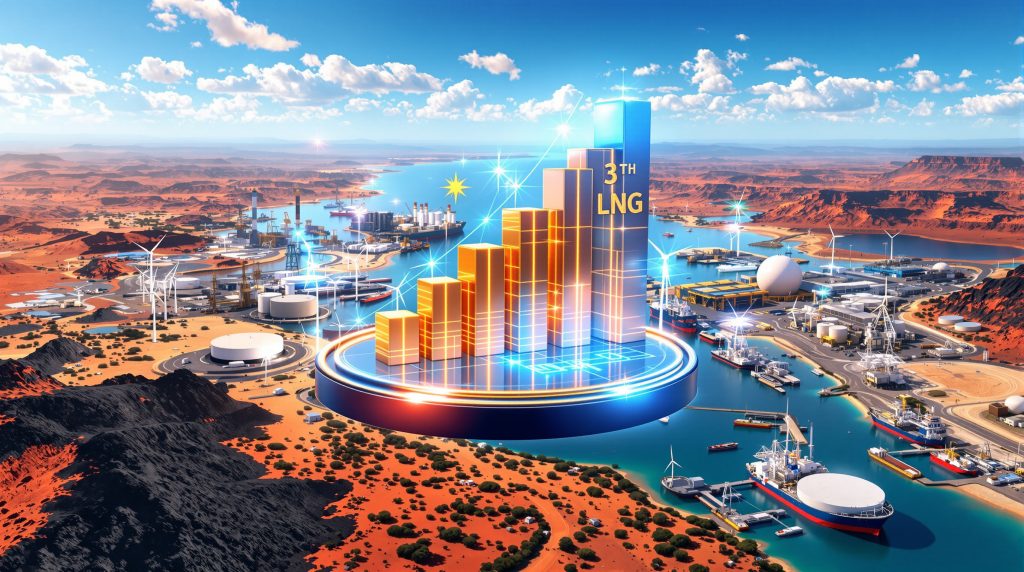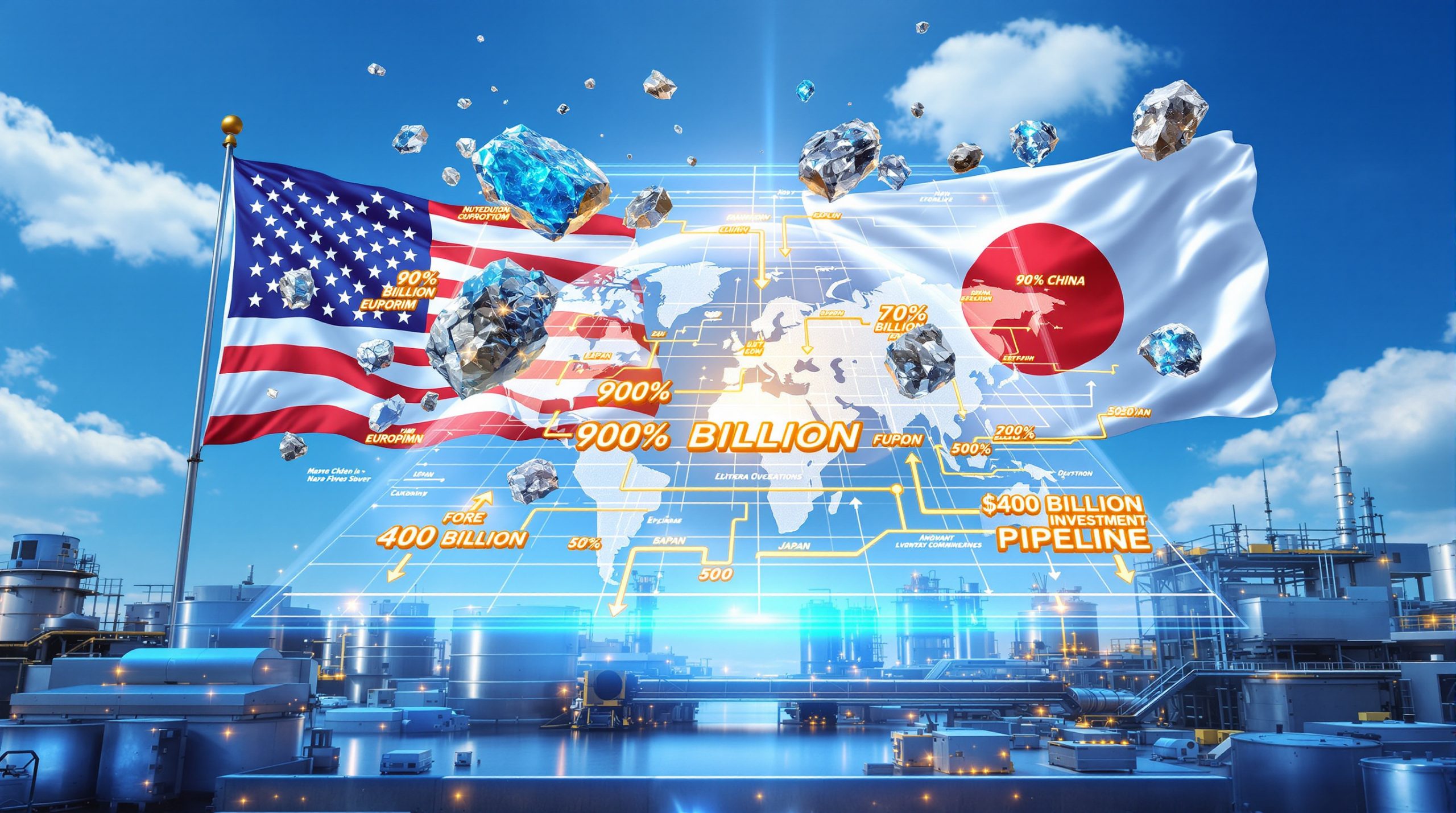Australia's Energy Resource Dominance Unveiled in AECR 2025
The release of Australia's Energy Commodity Resources (AECR) 2025 report has reinforced the nation's position as a global energy powerhouse, revealing commanding market positions across multiple energy sectors. This comprehensive analysis demonstrates how Australia leading global energy resources in AECR report continues to shape international energy markets while positioning itself for the evolving energy transition.
Australia exports more than seven times the energy it imports, creating an unprecedented 7:1 energy trade surplus that highlights the country's strategic importance in global energy security. With 80% of domestic energy production flowing to international markets, Australia's resources underpin energy security for nations worldwide.
The AECR 2025 findings reveal that Australia's energy export earnings reached A$238.7 billion in 2023, representing a substantial 17% year-on-year increase. These figures underscore the economic significance of the country's energy resources, even as global markets navigate decarbonisation pressures and shifting demand patterns.
Coal Industry: Maintaining Global Leadership Position
Australia's coal sector demonstrates remarkable resilience and scale within the global energy landscape. The nation holds the third-largest proven coal reserves globally while simultaneously operating as the world's second-largest coal exporter and fifth-largest producer by volume.
Regional distribution analysis reveals concentrated production across New South Wales and Queensland, where advanced mining operations leverage sophisticated extraction technologies. Despite facing headwinds from global decarbonisation initiatives, Australia's coal exports generated $103.2 billion in revenue during 2022-23, though this represented a 9.3% decline from the previous year's $113.8 billion.
Key Coal Industry Metrics:
- Third-largest global reserves holder
- Second-largest exporter worldwide
- Fifth-largest producer by volume
- $103.2 billion export earnings (2022-23)
- 9.3% revenue decline year-on-year
The coal sector's performance reflects broader global trends toward renewable energy adoption, yet demand from developing economies continues supporting Australia's export volumes. Furthermore, technological innovations in clean coal technologies and carbon capture systems represent potential pathways for extending the sector's relevance.
Natural Gas and LNG: Strategic Market Positioning
Australia's natural gas sector occupies a commanding position in global markets, ranking as the seventh-largest global gas producer and third-largest LNG exporter worldwide. The sector achieved record-breaking performance in 2023, exporting 80.7 million tonnes of LNG to international markets.
The resource base encompasses both conventional gas reserves and coal seam gas (CSG) deposits, creating a diversified production portfolio. However, the AECR identifies a critical challenge: conventional gas reserves are depleting faster than new discoveries can replace them, raising long-term supply security concerns.
Natural Gas Performance Indicators:
- 7th largest global producer
- 3rd largest LNG exporter
- 80.7 million tonnes exported (2023)
- Declining conventional reserves
- Growing CSG contributions
This supply dynamic necessitates increased exploration investment and technological advancement to maintain production levels. Consequently, the sector's strategic importance extends beyond revenue generation, serving as a crucial transition fuel supporting renewable energy integration through grid stability and backup power capabilities.
Uranium Reserves: Controlling Global Supply Chains
Australia's uranium sector demonstrates extraordinary global influence, controlling more than one-third of the world's known uranium reserves. Despite ranking as the fourth-largest global producer, contributing approximately 9% to worldwide uranium production, the country's resource base positions it as a critical supplier for global nuclear energy programs.
Geographic concentration primarily occurs within South Australia and Northern Territory, where regulatory frameworks permit uranium extraction. The absence of domestic nuclear power generation means 100% of production targets export markets, supporting peaceful nuclear energy programs worldwide through bilateral safeguards agreements.
Uranium Sector Highlights:
- 33%+ of global known reserves
- 4th largest worldwide producer
- 9% global production contribution
- 100% export-oriented production
- Bilateral safeguards compliance
Growing global interest in nuclear energy as a low-emission baseload power source continues driving demand for Australian uranium. In addition, the uranium market dynamics benefit from established supply chains, regulatory expertise, and long-term contracts that provide revenue stability.
Export Revenue Performance and Economic Impact
Australia's energy export performance in 2023 demonstrated remarkable resilience, generating A$238.7 billion in total earnings despite global economic uncertainties. This 17% year-on-year increase reflects strong international demand and favourable pricing conditions across multiple energy commodities.
The export composition reveals coal's continued dominance, with black coal exports contributing $103.2 billion to total earnings. However, the 9.3% decline in coal revenue signals shifting global energy priorities and increased competition from renewable alternatives.
"The Office of the Chief Economist projects energy export earnings will reach $369 billion for FY26, though this represents a reduction from the $385 billion forecast for FY25, reflecting higher trade barriers and softened global economic growth."
Revenue Breakdown by Sector:
- Total energy exports: $238.7 billion (2023)
- Black coal exports: $103.2 billion
- LNG and gas exports: Significant contributor
- Uranium exports: Niche but strategic
- Future projection: $369 billion (FY26)
How Do Trade Barriers Affect Australia's Energy Exports?
While Australia maintains overwhelming export dominance in energy commodities, the nation faces strategic vulnerabilities from global trade barriers. Heavy reliance on crude oil and refined petroleum product imports creates supply chain dependencies that require careful risk management.
The 7:1 export-to-import ratio masks critical import dependencies for transportation fuels and specialised petroleum products. This imbalance necessitates strategic petroleum reserves and diversified supply arrangements to ensure domestic energy security during global disruptions.
Import dependency analysis reveals:
- Heavy crude oil import reliance
- Refined petroleum product dependencies
- Strategic reserve requirements
- Supply chain diversification needs
- Energy security considerations
However, oil price trends continue to influence Australia's import costs, creating additional economic pressures on the energy trade balance.
Clean Energy Transition and Investment Surge
Australia's commitment to energy transition gained momentum in 2023, with $1.47 billion in total energy exploration expenditure representing an 18% increase from 2022's $1.25 billion investment. This surge reflects growing confidence in clean energy technologies and carbon capture solutions.
The regulatory landscape supports transition initiatives through 17 active offshore greenhouse gas storage assessment permits, facilitating carbon capture and storage (CCS) development. Combined investment in CCS and low-emissions projects approached $1 billion, establishing Australia as an international benchmark for clean energy innovation.
Clean Energy Investment Metrics:
- $1.47 billion exploration expenditure (2023)
- 18% increase from 2022 levels
- 17 offshore storage permits active
- ~$1 billion CCS investment
- International benchmarking position
These investments position Australia strategically for the global energy transition while maintaining competitiveness in traditional energy markets. For instance, the dual approach enables gradual transition without sacrificing existing revenue streams.
Renewable Energy Infrastructure Development
Australia's renewable energy sector demonstrates substantial progress, with solar power contributing 21% of the electricity mix and wind energy providing 14% of national generation capacity. This renewable contribution supports grid stability while reducing emissions intensity.
Infrastructure development encompasses large-scale solar installations, offshore wind projects, and advanced energy storage systems. Renewable energy innovations drive grid integration challenges and facilitate innovation in smart grid technologies and distributed energy management systems.
Renewable Energy Statistics:
- Solar power: 21% electricity contribution
- Wind energy: 14% generation share
- Grid integration advancing
- Storage solutions expanding
- Net-zero 2050 pathway alignment
The renewable energy trajectory supports Australia's net-zero by 2050 commitment while creating new export opportunities in green hydrogen and renewable energy technologies. Furthermore, the Australian Energy Commodity Resources Report confirms these positive trends across the renewable sector.
Global Resource Comparison and Market Share
| Resource Type | Global Ranking | Market Share | Key Performance Metrics |
|---|---|---|---|
| Coal Reserves | 3rd largest | – | Third-largest proven reserves globally |
| Coal Exports | 2nd largest | – | Major Asia-Pacific supplier |
| LNG Exports | 3rd largest | – | 80.7 million tonnes (2023) |
| Uranium Reserves | 1st largest | 33%+ | One-third of world's known resources |
| Gas Production | 7th largest | – | Conventional and CSG combined |
This comparative analysis demonstrates Australia's multi-faceted energy resource dominance, with leadership positions across traditional and emerging energy commodities. The diversified portfolio provides resilience against market volatility and transition risks.
Resource Depletion and Discovery Challenges
Critical resource sustainability concerns emerge from the AECR analysis, particularly regarding conventional gas reserves depleting faster than replacement discoveries. This trend necessitates accelerated exploration programmes and enhanced recovery technologies to maintain production levels.
Coal seam gas resources face similar sustainability questions, though technological advances in extraction techniques continue improving recovery rates. However, the depletion-discovery imbalance requires strategic planning to ensure long-term energy security.
Resource Sustainability Factors:
- Conventional gas depletion accelerating
- Discovery rates lagging replacement needs
- CSG sustainability concerns growing
- Enhanced recovery technology requirements
- Strategic exploration investment needs
Investment in geological surveys, advanced exploration techniques, and resource assessment capabilities becomes increasingly critical for maintaining Australia leading global energy resources in AECR report status.
Strategic Supplier Reliability and Trust
Australia's reputation as a trusted, stable, and reliable energy exporter provides competitive advantages in global markets. This reliability stems from robust regulatory frameworks, transparent governance, and consistent supply performance across multiple decades.
The bilateral safeguards agreements for uranium exports exemplify Australia's commitment to responsible resource development, ensuring peaceful-use-only commitments that build international confidence. This approach extends across all energy commodities, creating premium market positioning.
Reliability Indicators:
- Decades of consistent supply performance
- Transparent regulatory frameworks
- Bilateral agreement compliance
- Peaceful-use guarantees
- Stable political environment
Geographic Advantage and Infrastructure Capabilities
Australia's strategic location provides proximity to major Asian energy markets, reducing transportation costs and delivery times compared to alternative suppliers. This geographic advantage combines with world-class infrastructure including deep-water port capabilities for bulk commodities and advanced loading facilities.
Infrastructure advantages include:
- Proximity to Asian growth markets
- Deep-water port capabilities
- Advanced bulk handling facilities
- Established shipping routes
- Integrated supply chain networks
These infrastructure capabilities support efficient commodity movement from mine to market, maintaining cost competitiveness in global energy trade.
Future Technology Integration and Opportunities
Emerging technology integration presents significant opportunities for Australia's energy sector, particularly in hydrogen production potential leveraging abundant renewable resources and critical minerals for renewable energy technologies. These developments create new revenue streams while supporting global decarbonisation efforts.
Emerging Technology Applications:
- Green hydrogen production scaling
- Critical minerals extraction
- Energy storage solutions advancement
- Smart grid integration
- Carbon utilisation technologies
The critical minerals transition creates additional opportunities for Australia's resource sector, while technology transfer initiatives and international cooperation frameworks enhance the country's position in next-generation energy markets.
Investment and Policy Outlook
Government support for clean energy transitions combines with private sector investment in decarbonisation technologies, creating favourable conditions for energy sector evolution. International cooperation frameworks facilitate technology sharing and market access while supporting responsible resource development.
Policy environment factors include:
- Clean energy transition support
- Private investment incentives
- International cooperation frameworks
- Regulatory certainty maintenance
- Technology development funding
Future regulatory trajectories indicate continued support for traditional energy exports while accelerating clean energy development, balancing economic stability with environmental objectives. Moreover, Australia's status as a global clean energy leader provides additional confidence for investors considering long-term commitments.
What Are the Key Investment Opportunities?
Australia's energy landscape presents diverse investment opportunities across traditional resource stability and clean energy transition prospects. Infrastructure development requirements create capital deployment opportunities while risk mitigation strategies help investors navigate market transitions.
Investment Considerations:
- Traditional energy resource stability
- Clean energy transition growth
- Infrastructure modernisation needs
- Risk diversification strategies
- Regulatory compliance requirements
Understanding federal and state government policies, environmental compliance requirements, and international trade agreement implications enables informed investment decision-making in Australia's evolving energy sector. Consequently, Australia leading global energy resources in AECR report continues to attract significant international investment interest.
Disclaimer: This analysis is based on publicly available information from the AECR 2025 report and associated government publications. Energy market forecasts involve inherent uncertainties, and investors should conduct independent due diligence before making investment decisions. Regulatory changes, technological developments, and global economic conditions may significantly impact future sector performance.
Source: Australia's Energy Commodity Resources (AECR) 2025, Geoscience Australia; Office of the Chief Economist; Australian Government Department of Industry, Science, Energy and Resources
Looking for Investment Opportunities in Australia's Energy Sector?
Discovery Alert's proprietary Discovery IQ model delivers real-time notifications on significant mineral and energy discoveries across the ASX, helping investors identify actionable opportunities in Australia's commanding energy resource landscape. Start your 30-day free trial today to position yourself ahead of the market and capitalise on the next major discovery in Australia's thriving energy sector.




